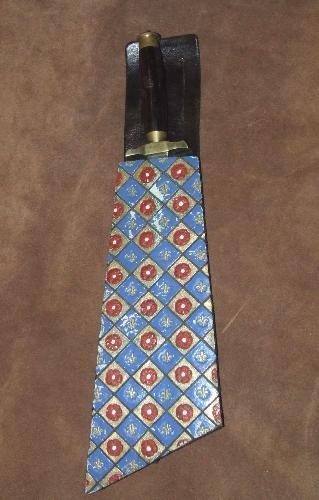-
Posts
5,928 -
Joined
Content Type
Profiles
Forums
Events
Blogs
Gallery
Everything posted by fredk
-
Here there are different levels of Spam; from the downright awful you wouldn't feed to your dog to the quite tasty stuff. All come in tins. The awful kind has loads of jelliefied fats but the nice stuff has minimal fat. I mostly avoid eating it as it reminds me of taking a packed sandwiches lunch to primary school This may be a measure of how it is disliked here; In the 1970s we had a national strike for 3 months. Everything became near impossible to buy due to shortages. But not spam. The shops always had plenty of stock of that!
-
Two boards and some C clamps or a solid surface, a mallet and a sacrificial piece of wood
-
Been thinking on this You have a sewing machine? put a 'leather' needle in, put leather under needle and turn machine manually, without thread. That will punch your holes
-
You don't need a proper leather working awl but could use one of these pokey-hole tools They can be bought cheaply. Put your leather over a plastic cutting board and push the pokey-hole tool through
-
It does cuir bouilli, literally Boiled Leather, sometimes using a hot wax bath
-
Only hot water from the tap, and not too hot at that Boiling hot water will really harden the leather but will make it shrink by as much as 20%, in uncontrolled directions
-
Dilute either the Future or Resolene 1:1 with water. Use several thinned coats, maybe 3. I prefer to use a version of 'Future' which I can get The paint won't help stiffen the leather Thin the paint and apply thin coats to build up the colour This knife scabbard was made in 2007, painted with acrylic model paints with no varnish to protect it. It was used regularly at events, tossed into a kit bag, generally neglected. It came back to me for repainting late 2016. After 10 years;
-
When moulding it; give it a good soaking and a little bit of stretching. Clamp it up and let it dry. Resolene will work if can soak in, so usually not chrome tan Floor wax ? do you men 'Mop & Glo'? despite what it says that is not a wax but an acrylic varnish You can use acrylic paints on leather. Any paints. Don't go buying expensive ones. I use paints meant for plastic models. They're cheap. They'll only crack off if you put the paint on really thick, which you won't have to do
-
Basically you have veg tan and chrome tan. Chrome tan is used on furniture are rarely can it be wet moulded to hold a shape. Chrome usually shows a blue line in centre when its cut. I see from your photos your leather is not showing this blue Veg tan can usually be wet moulded and when dry will hold its shape
-
1. If its veg tan leather you are molding it will hold its shape 2. Several coats of thinned water resistant PVA glue, or varnish 3. Try bees wax, rubbed in, it will protect the edge, not turn it too dark
-
Taking last first I've had aluminium corrosion being blue away from any contact with leather. When #1 son was younger he shaved his head. At one medieval history event he wore an aluminium chainmaille coif. (coif = head covering) It was a very hot day. He perspired a lot. When he took the coif off his head was covered in a pattern of blue circles. He told others that he was an ancient Briton! (who used to paint blue patterns on their bodies) I used brass washers as I didn't want to use steel. For that will give an electrolytic reaction*. And I didn't have aluminium The leather straps were un-dyed veg tan As far as I can remember the rivets diameter was less that 1/4 inch. Maybe 3/16" or 5/32" If I can find them I could measure. I was given about 2000 of them. Gave loads away for model steam engine building and used about 50 * in motor vehicle building we put a layer of sponge rubber between the steel frame and the aluminium body work otherwise if both were in contact during corrosion the aluminium acts as a sacrificial metal corroding away quickly PS; when setting the rivets and peening, I drilled a counter-sunk hole in a large steel plate and used that to support the round dome head
-
I used aluminium rivets on a few 'Viking' shields. They mainly held the boss on but also a hand-hold strap and also a carrying strap known as a guige. In use they were strong enuf for the shields to be flung about. In wet conditions the rivets corroded and left a blue stain on the leather. I changed to galvanized iron rivets. The aluminium rivets never failed despite the abuse the shields got The rivets were easy-peasy to set. I just peened them over using a ball-head hammer. I used ordinary brass washers on them
-

Accurately cutting "stretchy" leather.
fredk replied to Shadders's topic in Leatherwork Conversation
Heavy weights to hold down and a very sharp rotary knife. I use a 60mm diameter blade rotary knife -
Still getting my leatherwork room sorted. Its been a good opportunity to tidy it up and put things in proper places! and . . . I found an ice cold bottle of Newcastle Brown Ale on the bottom shelf of the fridge It ain't there no more !
-
Can't help re strength but aluminium corrodes quickly in damp/wet environments and leaves a blue stain on the leather
-
This is the penultimate report on Test Pieces Group 1 This Group has mainly been kept in a south facing car windshield. During the test time each piece was re-oiled once #1. Baby Oil; Flex - the same as Control #1, Smell - Slight smell of leather, Colour - Dark Brown, darker on front than rear, No fungus or rot #2. Cooking oil (rape seed oil); Flex - the same as Control #1, Smell - Slight smell of cooking oil, Colour - Dark Brown, same on front and rear, No fungus or rot #3. Lard (pork fats); Flex - about the same as Control #1, maybe slightly better, Smell - No smell, Colour - Light Tan, Same on front and rear, No fungus or rot #4. NFO Compound; Flex - about the same as Control #1, Smell - Very slight smell of leather, Colour - Dark Tan, Same on front and rear, No fungus or rot #5. Olive Oil (extra virgin / pure); Flex - about the same as Control #1, Smell - Very slight smell of leather, Colour - Dark Tan, Same on front and rear, No fungus or rot #6. 3-in-1 oil (contains benzine); Flex - slightly stiffer than Control #1, Smell - Very slight smell oil, Colour - Dark Tan, Same on front and rear, No fungus or rot #7. Vaseline (petroleum based); Flex - stiffer than Control #1, Smell - No smell, Colour - Nearly the same as Control, (which is like slightly darkened raw leather), Same on front and rear, No fungus or rot I'll try to do a report on Group 2, the pieces hanging outside This will be the penultimate report on that group as well as I'm thinking of ending this at the end of September or so 2 years, and we / I have discovered that a lot of these products can be used on leather without harm, all they may do is darken undyed leather
-
Very nice and very interesting. Looks easy enuff to replicate. I might try it on a sword/axe hangar
-
I would use WD40 to cut through any grime, then a light wash with warm soapy water to wash off the WD40
-
The way I hold knife to exert some pressure is to put my fore-finger on the blade. That hole would make an excellent finger locator
-
About £/$200. Its not hard to learn to use it. I think the resin gives a better print, less noticeable print lines, which don't matter at all for stamp making but I wanted it for printing DnD figures as well so a better sharpness was needed than I could get with the filament printers. Plus there are environment friendly resins, ie water based. Resin printers are safer than filament types. The filament type heats a coil of plastic and lays it down. If the plastic gets stuck it can overheat and start burning giving off toxic fumes and potentially setting fire to your building - it has happened. The resin does not need heating at all Takes the same time to print as a filament printer. But it prints your subject upside down by dipping in & out of a vat of resin. You don't know if the print is a success or has failed until the end when it finally raises the print clear of the vat The printing is very temperature sensitive. The printer, the resin and the room has to be at a constant 22* or more One thing more, Ppl are put off 3D printing because it 'takes 3 hours 45 minutes' (as an example) to print. Bu you are not sitting there very minute. You set it to print and go for lunch/make a belt/get a coffee hth
-
@SUP To misquote Julius Caesar, venerunt, viderunt, laboraverunt, They arrived at 07.30 and away by 14.50, Very much quicker than I thought, By several days! I might get things sorted by Tuesday and get back to this properly. But in the meantime I've got to knock-up a new belt for #1 son



